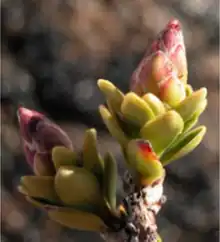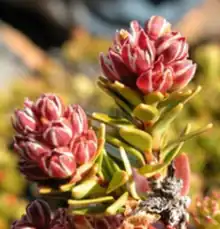Archeria serpyllifolia
Archeria serpyllifolia is a dense, compact, low growing shrub, that is endemic to Tasmania, Australia, inhabiting the undisturbed alpine areas of southern and south-west Tasmania.[2] This plant is commonly referred to by Australasian naturalists as thyme archeria.

| Archeria serpyllifolia | |
|---|---|
.jpg.webp) | |
| Scientific classification | |
| Kingdom: | Plantae |
| Clade: | Tracheophytes |
| Clade: | Angiosperms |
| Clade: | Eudicots |
| Clade: | Asterids |
| Order: | Ericales |
| Family: | Ericaceae |
| Genus: | Archeria |
| Species: | A. serpyllifolia |
| Binomial name | |
| Archeria serpyllifolia | |

Description
The Archeria genus is a part of the Ericaceae family, a family of flowering plants that is commonly referred to as the heath family. Archeria serpyllifolia is one of six species under the Archeria genus.[3] This shrub is characteristically woody and rigid, ranging from approximately 15–25 cm in height, and exhibiting fasciculate, ascending branches, that are somewhat glabrous in appearance. The leaves have a high resemblance to those of Epacris serpyllifolia, which are small (up to 5 mm long), suberect, elliptical-ovate in shape, very thick and coriaceous and exhibit a minutely serrate edge.[1] Leaves also display a few veins on their light green under surface and are generally blunter than those of the similar species Archeria comberi, which also differs in having solitary flowers.[2] The flowers are crowded on a short, erect terminal, with six to eight flowered racemes. The peduncles bracteate at the base, and pedicels have one bracteole at their insertion.[1]

Habitat and Distribution
Archeria serpyllifolia is endemic to south-western Tasmania.[2] It is largely found on acidic soils and grows in montane environments at higher altitudes in shrublands and forests.[3] This alpine shrub often inhabits areas of mainly unburnt vegetation.[2]

Etymology
This plant was named by British botanist Joseph Dalton Hooker in 1844, after the nineteenth century Tasmanian botanist William Archer.[4]
References
- Hooker, J.D. and Fitch, W.H. (1844) "The botany of the Antarctic Voyage of H.M. Discovery Ships Erebus and terror in the years 1839-1843: under the command of captain sir James Clark Ross, by Joseph Dalton Hooker"
- Jordan, G. (2019) Key to Tasmanian Vascular Plants, Key to Tasmanian dicots. University of Tasmania
- Crayn, D.M. and Quinn, C.J. (1998) “Archerieae: A new tribe in Epacridaceae,” Australian Systematic Botany, 11(1), p. 23.
- Morton, C.V. and Allan, H.H. (1967) Flora of New Zealand, volume I, indigenous Tracheophyta (Psilopsida, Lycopsida, Filicopsida, Gymnospermae, dicotyledones), American Fern Journal, 57(2), p. 93.